Abstract
The decision to purchase a Predictive Maintenance (PdM) system comes with unique challenges. The primary value of this technology lies in prevention—avoiding failures that the buyer ultimately does not experience. This specific benefit model, although confirmed in the literature, may raise uncertainty, especially in the face of difficulties in initially estimating the return on investment (ROI). This article analyzes these challenges from the perspective of a potential buyer, presents the possible benefits of implementing PdM, and identifies strategies to increase investment confidence and transparency in communicating value.
1. Introduction
PdM systems use advanced data analytics and machine learning algorithms based on production data to predict potential machine and equipment failures before they actually occur (Carvalho et al., 2019; Lee et al., 2015). Although scientific publications frequently emphasize the effectiveness and long-term benefits of PdM, from the perspective of a company considering a purchase, a specific problem arises: how to assess the value of a solution whose main advantage is preventing something that does not happen?
The perspective of a potential buyer differs from that of researchers or technology providers. Buyers expect tangible evidence, clear reasoning, and convincing data. This issue resembles the situation in the insurance or cybersecurity industries, where payments are made for risk prevention (Jimenez-Cortadi et al., 2019), and the effectiveness of the solution manifests in the absence of negative incidents. This article aims to help understand the nature of PdM benefits by drawing conclusions from scientific literature and implementation reports and highlighting practical strategies to minimize purchasing risk and uncertainty.
1.1. From Reactivity to Prediction – The Evolution of Maintenance Strategies
Maintenance plays a crucial role in ensuring the reliability, efficiency, and safety of technical systems in industry. The evolution of maintenance strategies—from reactive through preventive and proactive to predictive maintenance—reflects the growing importance of data, analytics, and new technologies in managing industrial infrastructure (Bocewicz et al., 2024).
Reactive Maintenance was the earliest form of failure management. Its goal is to restore functionality after a failure occurs. It is characterized by a lack of planning, high repair costs, and the risk of secondary damage and production downtime.
Preventive Maintenance introduced regular maintenance schedules aimed at reducing the risk of failure. This approach is time-consuming and costly, with limited flexibility in adapting to the actual technical condition of equipment.
Proactive Maintenance represents a step forward, focusing on identifying and eliminating root causes of faults. It utilizes wear indicators, environmental analysis, and weather forecasts to effectively plan repair activities (see Table 1).
Tab. 1 Traditional Maintenance Strategies (based on Bocewicz, et al. 2024)
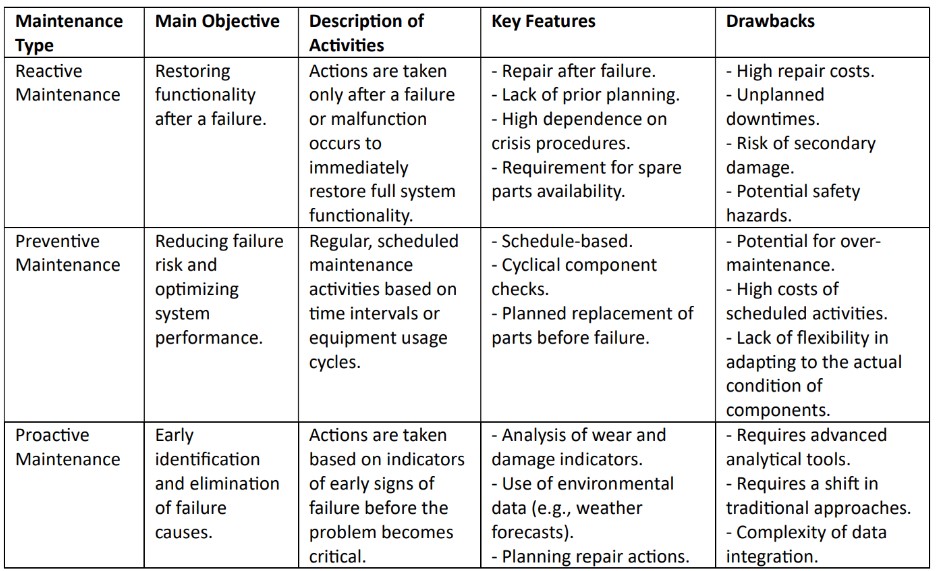
As technology advances, proactive maintenance has begun to give way to predictive maintenance, which relies on real-time data analysis and machine learning algorithms. Unlike proactive maintenance, which focuses on analyzing historical failure causes, predictive maintenance enables dynamic failure forecasting based on current sensor data (see Table 2).
Tab. 2 Differences Between Proactive Maintenance and Predictive Maintenance
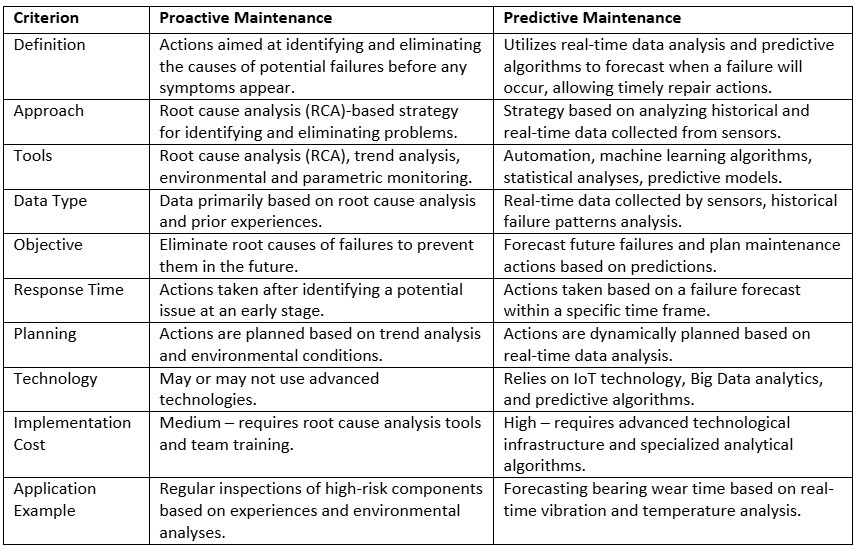
2. Why is it difficult to assess the value of PdM from the buyer’s perspective?
Assessing the value of PdM from a buyer’s perspective is one of the main challenges associated with implementing this technology. Scientific literature emphasizes that these difficulties arise from both the nature of the value offered and the complexity of the implementation process, as well as cost-benefit analysis.
The most significant source of uncertainty in assessing PdM is the intangible nature of its benefits. In traditional maintenance models, companies pay for specific repair services, spare parts, or corrective work, which are easy to quantify and evaluate (Klees & Evirgen, 2022). PdM, on the other hand, offers risk reduction for costly failures, and the system’s success is measured by the absence of negative events rather than the delivery of a tangible product or visible intervention. This situation is analogous to the insurance industry, where the value of a service is assessed through the absence of incidents rather than specific actions (Jimenez-Cortadi et al., 2019).
Estimating the return on investment (ROI) for PdM is particularly challenging, especially in the initial stages of implementation. Lee et al. (2015) indicate that PdM benefits become apparent over time when sufficient data is available to compare the frequency, costs, and consequences of failures before and after system implementation. Initially, with limited data, it is difficult to calculate financial benefits conclusively. Companies may struggle to justify high initial costs without clear success indicators.
Traditional maintenance methods have well-defined performance metrics, such as Mean Time Between Failures (MTBF) and Mean Time To Repair (MTTR). In contrast, PdM lacks standardized metrics and universally accepted indicators of effectiveness. This complicates comparisons of PdM efficiency with traditional maintenance strategies and makes financial justification of PdM implementation more challenging.
The effectiveness of PdM is directly linked to the quality of collected data and the organization’s ability to analyze it effectively. Data gathered by IoT sensors and systems must not only be accurate but also properly analyzed using advanced algorithms. Organizations without experience in data analysis may face difficulties in fully utilizing PdM’s potential, which in turn leads to uncertainty about the actual benefits of implementing this strategy.
Cost analysis associated with PdM implementation (see Table 3) highlights significant differences between this method and traditional maintenance strategies. Scientific literature emphasizes that PdM implementation costs can be significantly reduced by leveraging existing historical data and appropriate analytical methods, minimizing the need for additional sensor deployment. Traditionally, PdM implementation required installing advanced sensors and monitoring systems, generating high costs. However, research indicates that it is possible to apply analytical methods based on historical data from previous maintenance activities, significantly reducing the need for additional sensors. Analyzing data from past service interventions and failure histories allows building predictive models without investing in new measurement equipment. This approach not only reduces implementation costs but also shortens the time required to deploy a PdM system. Using advanced data analysis algorithms, such as machine learning, enables effective prediction of potential failures based on existing data. As a result, organizations can implement PdM without significant investments in new measurement technologies while achieving higher operational efficiency and infrastructure reliability.
Tab. 3 Cost Analysis of PdM Implementation
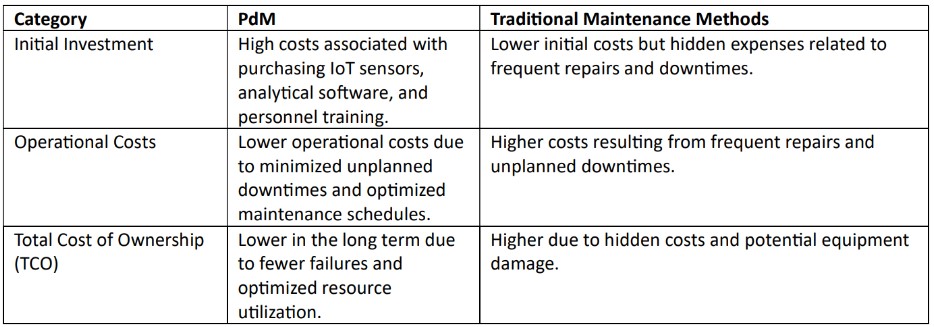
3. Potential Benefits of PdM Implementation Despite Initial Uncertainty
Traditional maintenance approaches focus either on preventive or reactive equipment repair or replacement only after failure. PdM represents a fundamental shift in maintenance strategies, relying on data analysis, sensor technology, and machine learning algorithms to predict failures before they occur, enabling proactive planning of maintenance activities (Carvalho et al., 2019; Poór et al., 2019; Wellsandt et al., 2016; Patel et al., 2023). The key benefits include:
- Reduced Failure and Repair Costs: Early detection of potential problems prevents serious damage that would generate high repair costs.
- Increased Reliability and Equipment Availability: Stable machine operation translates into predictable production, reduced downtimes, and improved resource utilization, ultimately increasing Overall Equipment Effectiveness (OEE).
- Extended Infrastructure Lifecycle: Continuous monitoring and prevention result in less wear and tear on components and machines, delaying the need for modernization or replacement of key assets (Maktoubian & Ansari, 2019).
- Improved Safety and Work Quality: Reducing the risk of unexpected failures not only lowers costs but also increases employee safety and process stability.
Tab. 4 Benefits and Concerns of Predictive Maintenance Implementation
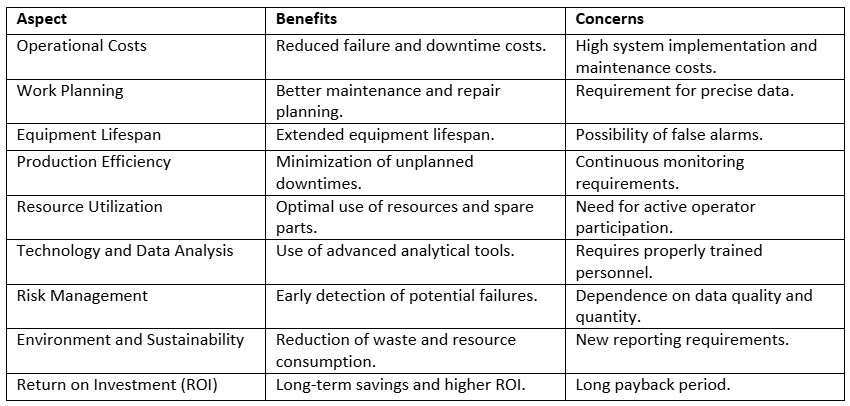
4. How to Reduce Investment Uncertainty and Risk?
From the perspective of a buyer hesitant about investing in PdM, scientific literature identifies several key factors for minimizing uncertainty related to the implementation of this solution. Effective PdM implementation requires a comprehensive approach that integrates technological, organizational, and human aspects. Both proper management of the implementation process and the engagement of all stakeholders are crucial.
The following table presents the main strategies identified in scientific literature that play a significant role in the successful implementation of PdM. Each strategy focuses on a different aspect of managing this process, highlighting key challenges and recommended actions that can significantly enhance the efficiency and effectiveness of implementation.
Tab. 5 Tab. 5 PdM Implementation Strategies
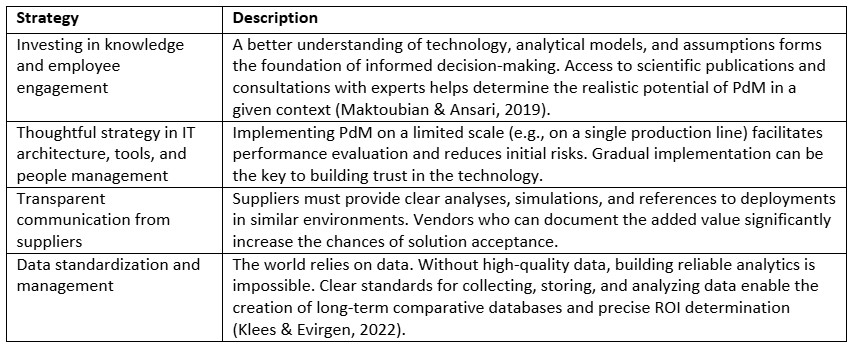
4.1. Integration of Technology, Organizational Culture, and Team Competencies as a Foundation for Effective Implementation
The foundation of successful PdM implementation lies in comprehensive employee education. Workers must understand how the system operates, the benefits of its implementation, and their roles in the entire process. Both theoretical and practical training play a key role in improving staff competencies, enabling them to effectively recognize maintenance needs and respond quickly to potential threats.
At the same time, from a management perspective, PdM success largely depends on a shift in organizational culture. It is necessary to create an environment that fosters collaboration between maintenance, production, and IT departments. Such an approach facilitates better coordination of activities and seamless integration of analytical models. Research indicates that effective team integration supports knowledge exchange and allows continuous adjustment of maintenance strategies to changing organizational needs.
In the context of research on maintenance management models, the mutual relationship between machine performance and quality requirements in the production process is crucial. Studies show that using machine learning algorithms allows maintenance and production managers to plan maintenance activities based on real-time monitoring of machine parameters and quality indicators. This ensures not only production continuity but also minimizes the number of products that fail to meet specifications.
From a management perspective, PdM research emphasizes the importance of evaluating the relationships between maintenance costs and quality costs. Integrating these two areas into a single coherent management model allows organizations to more precisely allocate resources and optimize operational processes. PdM implementation not only reduces failure risks but also supports long-term business goals related to production quality and efficiency.
At the operational level, PdM requires continuous monitoring and optimization. Organizations must implement mechanisms that enable regular evaluation of predictive model performance and fine-tuning algorithms based on current production data. This is a dynamic process requiring close cooperation between all involved departments. Only through an integrated approach, encompassing both technology and organizational culture, can PdM’s potential be fully utilized and sustainable benefits achieved for the enterprise.
4.2. Gradual Implementation Strategy: Minimizing Risk and Building Trust
Implementing PdM on a limited scale, such as on a single production line, is an effective strategy for minimizing initial risk and facilitating performance evaluation. This approach allows organizations to collect necessary data, identify potential problems, and tailor the technology to specific operational conditions. Research indicates that gradual PdM implementation can be key to building trust in this technology, both among management and operational staff. Pilot PdM programs demonstrate benefits such as reducing unplanned downtimes, lowering maintenance costs, and improving operational efficiency. This enables organizations to better understand the technical and organizational requirements associated with full PdM deployment, leading to more informed investment and operational decisions.
Literature also emphasizes the importance of integrating PdM tools with existing IT systems and training personnel in new technologies. Gradual implementation facilitates better management of these aspects, minimizing disruptions to daily operations and ensuring a smooth transition to a new maintenance model. As a result, organizations can gradually adapt to changes, increasing acceptance of new solutions and promoting their long-term efficiency.
An example is the pilot implementation of PdM in a manufacturing company, where the technology was applied to a selected production line. This pilot resulted in significant reductions in unplanned downtimes and optimized maintenance schedules, convincing management to expand PdM across other production areas.
This approach allows organizations to gradually build competencies in PdM and develop technical infrastructure tailored to their specific needs and capabilities.
4.3. The Importance of Transparent Supplier Communication in Implementation
Transparent and open communication from PdM technology suppliers plays a key role in the decision-making process for companies considering implementing such solutions. Suppliers who can provide clear analyses, simulations, and references to successful implementations in similar environments significantly increase the likelihood of their systems being accepted. Scientific literature emphasizes that documenting the added value of PdM not only builds trust but also simplifies the adaptation process, enabling organizations to make more confident investment decisions.
An example highlighting the importance of such communication is a McKinsey & Company report, which indicates that implementing PdM strategies can yield savings of 10% to 40% in maintenance-related costs and reduce capital expenditures on equipment and machinery by up to 5%. These data, supported by specific analyses and case studies, provide a solid foundation for investment decisions and convince management of the profitability of PdM implementation.
The educational aspect is equally important. Suppliers who actively engage in educating their clients by offering training and technical support in integrating PdM systems with existing IT infrastructure play a crucial role in the efficiency of implementation. Research indicates that integrating PdM tools with production management systems and adequately preparing personnel are foundational for the long-term effectiveness of predictive maintenance systems.
The value of cooperation with suppliers also depends on their ability to present successful implementations in production environments with similar parameters and challenges. Practical PdM application examples help potential clients better understand both the opportunities and limitations of this technology. Case studies serve as a roadmap, identifying potential implementation challenges while illustrating measurable benefits and tangible results. As a result, organizations can make more informed and data-driven decisions regarding PdM implementation.
4.4. Standardization and Data Management as the Key to Effective Analytics and Precise ROI Determination
Today’s world relies on data, which has become an indispensable element of organizational operations. However, for data analytics to be reliable and provide real benefits, it is essential to ensure high data quality. Without proper standardization of data collection, storage, and analysis processes, it is difficult to achieve reliable results that effectively support decision-making processes at various management levels.
Data standardization involves unifying formats and structures of information from different sources, enabling effective comparison and analysis. Research shows that standardizing these processes significantly improves the quality of business decisions, allowing the consolidation of various sources of information into a cohesive and unified whole. As a result, management and analysts gain access to more precise and complete data, directly contributing to better strategic decisions and more efficient resource management. Equally important is data management, which encompasses the processes of collecting, storing, protecting, and analyzing data.
Clear standards for collecting, storing, and analyzing data enable the creation of long-term comparative databases that support organizational performance monitoring over time. These databases facilitate identifying trends and precisely evaluating the effectiveness of implemented management strategies. In data analysis, best practices focus on defining clear analysis objectives, systematically collecting data from various sources, and continuously monitoring and controlling data quality. Ensuring the accuracy and reliability of this data becomes the foundation for making effective managerial decisions.
The ultimate goal of these activities is to precisely determine the return on investment (ROI) in the context of data management. High-quality data, carefully analyzed, forms the basis for reliably assessing the profitability of investments in data management technologies and tools. Research indicates that data management processes, like any other business project, should have a defined ROI indicator. A reliable analysis of profitability requires moving from general assumptions to detailed performance metrics, allowing the precise identification of benefits resulting from improved data quality.
5. Summary
From the perspective of a potential PdM system buyer, a natural dilemma arises: how to pay for value that is not immediately visible, and how to trust technology that promises the absence of certain events instead of delivering tangible products or services? Scientific literature, previous implementations, and examples from other sectors suggest that although it is initially difficult to estimate ROI, over time, as data and experience accumulate, the benefits become clear and measurable.
Through education, gradual implementation, transparent supplier communication, and data standardization, uncertainty and risk can be significantly reduced. As a result, investing in PdM, though based on prevention and invisible effects, can prove to be one of the most valuable and strategic moves for companies striving for long-term stability and competitiveness.
Bibliography
Bocewicz, G., Frederiksen, R., Nielsen, P., Banaszak, Z. (2024). Integrated preventive–proactive–reactive offshore wind farms maintenance planning. Annals of Operations Research. 1-32. 10.1007/s10479-024-05951-4.
Carvalho, T. P., Soares, F. A. A. M. N., Vita, R., Francisco, R. D. P., Basto, J. P., & Alcalá, S. G. S. (2019). A systematic literature review of machine learning methods applied to predictive maintenance. Computers & Industrial Engineering, 137, 106024.
Jimenez-Cortadi, A., Irigoien, I., Boto, F., Sierra, B., & Rodriguez, G. (2019). Predictive maintenance on the machining process and machine tool. Applied Sciences, 9(21), 4506.
Klees, M., Evirgen, S. (2022). Building a smart database for predictive maintenance in already implemented manufacturing systems. Procedia Computer Science, 204, 14-21.
Lee, J., Ardakani, H. D., Yang, S., & Bagheri, B. (2015). Industrial big data analytics and cyber-physical systems for future maintenance & service innovation. Procedia CIRP, 72, 267–272.
Maktoubian, J., & Ansari, K. (2019). An IoT architecture for preventive maintenance of medical devices in healthcare organizations. Health and Technology, 9, 233–143.
Patel, M., Vasa, J., Patel, B. (2023) Predictive Maintenance: A Comprehensive Analysisand Future Outlook. 2023 2nd International Conference on Futuristic Technologies (INCOFT)Karnataka, India. Nov 24-26
Poór, P., Ženíšek, D., & Basl, J. (2019). Historical overview of maintenance management strategies: Development from breakdown maintenance to predictive maintenance in accordance with four industrial revolutions. Proceedings of the International Conference on Industrial Engineering and Operations Management.
Wellsandt, S., Nabati, E., Wuest, T., Hribernik, K. A., & Thoben, K. D. (2016). A survey of product lifecycle models: Towards complex products and service offers. International Journal of Product Lifecycle Management, 9(4), 353-390.
